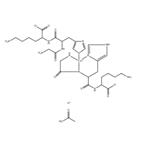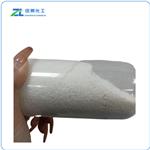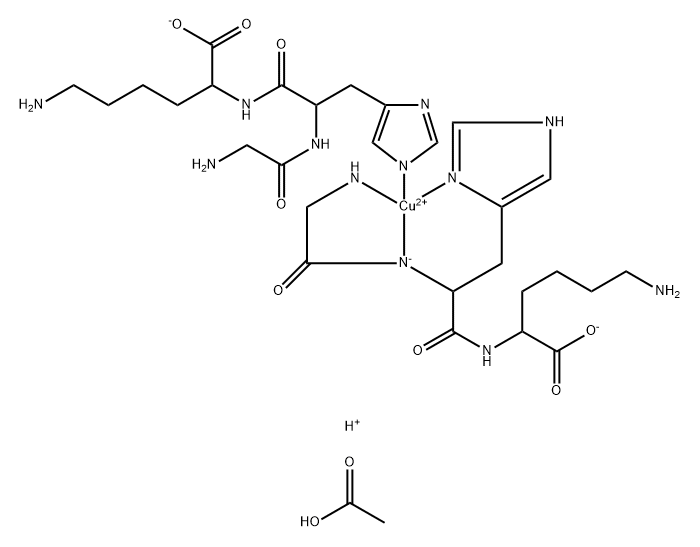Multifunctional Bioactivity and Applications of Copper Tripeptide-1
Introduction
Copper tripeptide-1 is a small protein composed of the three amino acids (protein building blocks) glycine, histidine, and lysine combined in a specific geometric configuration with the physiologically beneficial mineral copper. It is sometimes abbreviated GHK-Cu, indicating the chemical symbols for the four molecules composing it. These three amino acids have a very high affinity (attraction) for copper and are often found in association with this mineral in biologic systems. Within the body, copper tripeptide-1 may be found both complexed with or without copper, although the form including copper is more beneficial. Since 1973 when copper tripeptide-1 was discovered to cause aged liver cells to behave like young liver cells, a large body of scientific evidence has accumulated regarding the safety and beneficial effects of this fascinating compound. [1]

Copper Tripeptide-1 in Wound Healing
Copper tripeptide-1, which was first described as a growth factor for a variety of differentiated cells, modulates the formation of new connective tissue. In addition, recent studies have shown that copper tripeptide-1 plays a physiological role in the process of wound healing and tissue repair by stimulating collagen synthesis in fibroblasts. Further study reported that copper tripeptide-1 may increase the proliferative potential of keratinocytes by regulating extracellular matrix proteins such as α6 and β1 integrins. Interestingly, it is reported that copper can alter the keratinocyte integrin expression during the re-epithelization and remodeling phases of wound healing. [2]
Tissue remodeling follows the initial phase of wound healing and stops inflammatory and scar-forming processes, then restores the normal tissue morphology. The human peptide Gly-(L-His)-(L-Lys) or GHK, has a copper 2+ (Cu2+) affinity similar to the copper transport site on albumin and forms copper tripeptide-1, a complex with Cu2+. These two molecules activate a plethora of remodeling related processes: (1) chemoattraction of repair cells such as macrophages, mast cells, capillary cells; (2) anti-inflammatory actions (suppression of free radicals, thromboxane formation, release of oxidizing iron, transforming growth factor beta-1, tumor necrosis factor alpha and protein glycation while increasing superoxide dismutase, vessel vasodilation, blocking ultraviolet damage to skin keratinocytes and improving fibroblast recovery after X-ray treatments); (3) increases protein synthesis of collagen, elastin, metalloproteinases, anti-proteases, vascular endothelial growth factor, fibroblast growth factor 2, nerve growth factor, neutrotropins 3 and 4, and erythropoietin; (4) increases the proliferation of fibroblasts and keratinocytes; nerve outgrowth, angiogenesis, and hair follicle size. Copper tripeptide-1 stimulates wound healing in numerous models and in humans. Controlled studies on aged skin demonstrated that it tightens skin, improves elasticity and firmness, reduces fine lines, wrinkles, photodamage and hyperpigmentation. Copper tripeptide-1 also improves hair transplant success, protects hepatic tissue from tetrachloromethane poisoning, blocks stomach ulcer development, and heals intestinal ulcers and bone tissue. These results are beginning to define the complex biochemical processes that regulate tissue remodeling. [3]
Implications of Copper Tripeptide-1 for Cognitive Health
Oxidative stress, disrupted copper homeostasis, and neuroinflammation due to overproduction of proinflammatory cytokines are considered leading causative factors in development of age-associated neurodegenerative conditions. Recently, a new mechanism of aging—detrimental epigenetic modifications—has emerged. Thus, compounds like copper Tripeptide-1 that possess antioxidant, anti-inflammatory activity as well as compounds capable of restoring copper balance and proper gene functioning may be able to prevent age-associated cognitive decline and ward off many common neurodegenerative conditions. Numerous studies demonstrating pleiotropic health promoting and antiage activity of the copper tripeptide-1 peptide together with recent studies revealing gene regulating activity of GHK suggest that this compound may belong to a class of epigenetic modifiers capable of exhibiting broad protective and restorative actions, reducing harmful epigenetic changes caused by environmental perturbagens. The copper tripeptide-1 peptide should be considered a promising neuroprotective agent capable of preventing the development of common age-associated neurodegenerative disorders. [4]
Gene Regulation by Copper Tripeptide-1
Copper tripeptide-1 has a long history of safe use in wound healing and skin care; it is naturally occurring, nontoxic, and is active at a very low nanomolar concentration. It readily forms complexes with copper, regulating its metabolism and improving its bioavailability. It possesses antioxidant, anti-inflammatory, and regenerative properties, improves circulation, supports stem cell functions, and promotes nerve outgrown and synthesis of neurotrophic factors. Recent studies demonstrated its ability to regulate a large number of human genes. At 1 micromolar it was able to suppress 70% of genes overexpressed in metastatic colon cancer. It upregulates p63 and integrins in epidermal stem cells, increases collagen, glycosaminoglycans, and decorin expression. The studies with the Broad Institute’s Connectivity Map revealed its ability to regulate a large number of human genes including those that are involved in nervous system physiology, development, and maintenance. [4]
References:
[1] DeHaven, C. (2014). Copper Tripeptide-1. Science of Skincare, 1-4.
[2] Choi, H. R., Kang, Y. A., Ryoo, S. J., Shin, J. W., Na, J. I., Huh, C. H., & Park, K. C. (2012). Stem cell recovering effect of copper‐free GHK in skin. Journal of Peptide Science, 18(11), 685-690.
[3] Pickart, L. (2008). The human tri-peptide GHK and tissue remodeling. Journal of Biomaterials Science, Polymer Edition, 19(8), 969-988.
[4] Pickart, L., Vasquez-Soltero, J. M., & Margolina, A. (2012). The human tripeptide GHK‐Cu in prevention of oxidative stress and degenerative conditions of aging: implications for cognitive health. Oxidative medicine and cellular longevity, 2012(1), 324832.
See also
Lastest Price from Prezatide copper acetate manufacturers

US $2.00-5.00/kg2025-06-17
- CAS:
- 130120-57-9
- Min. Order:
- 1kg
- Purity:
- 99%
- Supply Ability:
- 100kg

US $50.00/kg2025-04-21
- CAS:
- 130120-57-9
- Min. Order:
- 1kg
- Purity:
- 99
- Supply Ability:
- 5000

